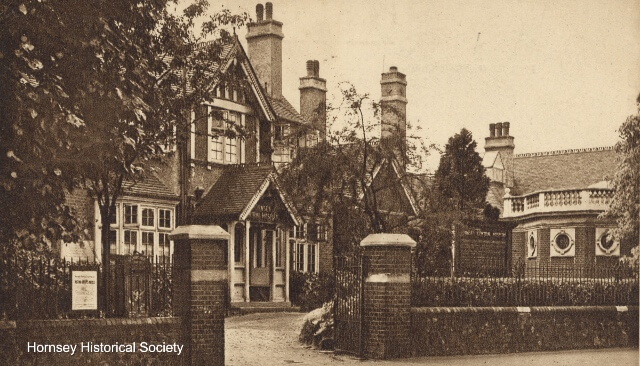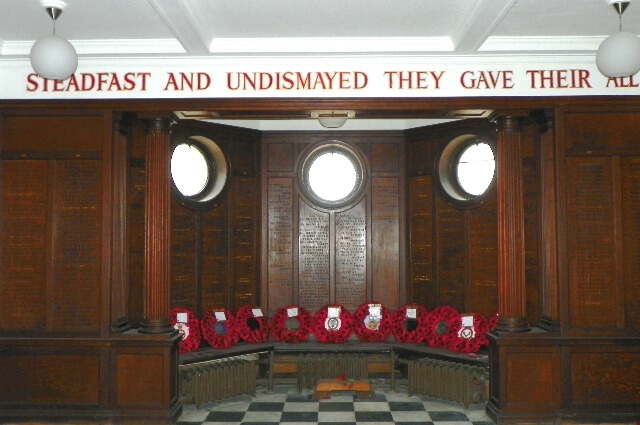We may think that we have nothing in common with the people who waited silently and reflectively at the opening of the Hornsey War Memorial in Park Road on 11th November 1921 but that is not so. We are joined by the word ‘pandemic’, not Spanish Flu this time but Covid 19, and how many people waiting patiently the mandatory 15 minutes after their first, second or booster Covid jab in a room off Hornsey Central Neighbourhood Health Centre in Park Road, N8, realise that they are sitting inside the Hornsey War Memorial?
The background
We left this story when it was part of the series, Reflections on 1919. Choosing a suitable war memorial to honour Hornsey’s Fallen in The Great War, 1914-18, was an emotional and contentious issue. What should it look like to honour ‘our boys’ appropriately, how much would it cost and who should pay? In February 1919, Hornsey residents made the decision that the memorial should be connected in some way to Hornsey Cottage Hospital.
In August 1919 the Hornsey Journal featured a message from the Mayor asking for a full list of Hornsey residents who had lost their lives in the Great War for inclusion on the War Memorial. Forms to fill in the details of name, rank and regiment were provided in local libraries. The conclusion to that article read, ‘It was to be Armistice Day, 11th November 1921, before the War Memorial in front of Hornsey Cottage Hospital was opened and dedicated by the Bishop of Willesden. Ironically, this is the only part of Hornsey Cottage Hospital which survives today’. Little did the writer know what was to follow in 2020!
Preparations for the War Memorial
The finalised Borough War Memorial scheme was for it to be the entrance hall to Hornsey Cottage Hospital, funded entirely by public subscription at a cost of £3,400. A second portion of the scheme was to use more funding to add a new wing to the hospital providing accommodation for 24 additional beds at an estimated cost of £22,000. Over £8,000 had been promised already, mostly by public subscription, together with small amounts from various hospital charities. Regiments, churches, schools and other organisations had their own memorials.
The Hornsey War Memorial Committee, chaired by the out-going Mayor, Alderman Jesse Dunmore, planned the event for November 1921. As it happened, Hornsey’s Conservative Member of Parliament, Kennedy Jones, died on 20th October 1921 and his funeral took place at Golders Green Crematorium on 24th. A quick by-election followed on 10th November at which a new Conservative MP was elected, Lord Edman. All this added to the drama around the 11th November event.
The design of Hornsey’s War Memorial
The architect was George Lethbridge FRIBA who had designed Hornsey Cottage Hospital in 1907. The exterior of the memorial was red brick with Portland stone dressing. Above the oak entrance door on stone were carved the coat of arms of Hornsey Borough with ‘‘The Hornsey War Memorial’ below. Either side of the entrance were the dates 1914 and 1919, also carved in stone.

The interior Memorial Hall was lit by a skylight and 3 circular windows glazed with antique tinted glass. The floor was black and white marble laid in squares. The walls were lined with English oak panels on which the names of 1,200 of Hornsey’s Fallen were grouped under the headings Navy, Merchant Services, Air Force and various Army regiments. Above the panelling were inscribed in capital letters the following sentences: ‘Their Name Liveth For Evermore’; ‘They Died That You Might Live in Peace and Honour’; ‘Faithful Unto Death’ and ‘Steadfast And Undismayed They Gave Their All’.

The Opening of the Hornsey War Memorial
A full account of this event, held at the 11th hour, on 11th day of the 11th month, was recorded in the 18th November 1921 edition of the Hornsey Journal. It began, ‘Three years have not served to dim the fragrance of the memory of our honoured dead’. It was a cold, frosty morning. By 10.30am the enclosure in front of the Memorial was packed with a silent crowd, 5,000 in number, most wearing black. A number of children were present ‘because of daddy’. The Police, cadets and boy scouts had been drafted in to help. They handed out the order of service, which carried a picture of the memorial on the front and the boy scouts formed a guard of honour for the procession.
Shortly before 11.00am, Dr Walter Robson, organist of Christ Church, Crouch End, led the procession, followed by surpliced boy choristers, the Bishop of Willesden, Dr Perrin, the Rector of Hornsey, Rev. Bernard Spink, the newly elected Mayor of Hornsey, Cllr. Ben Holmes Jenkinson JP, the out-going Mayor Jesse E Dunmore, members of the Town Council, the War Memorial Committee, the Cottage Hospital Committee, followed by the Matron and nurses. Also in the procession were Lord Ednam, the newly elected MP, and his Liberal opponent Leslie Bargin, ‘the unity of all parties in paying tribute to our honoured dead’ said the Hornsey Journal. This sounds familiar in light of the recent murder of Sir David Ames MP.
There were the inevitable speeches. The Secretary of the Hornsey War Memorial Committee, Mr E O Whitehead, expressed the indebtedness of Committee to the Town Clerk, Mr Askey, to Mr Lovegrove, the Borough Engineer and Surveyor, ‘in relation to the architectural details of the memorial,’ and to Mr Johnson, Chief Librarian, who had collated and tabulated the 1,200 names of the Fallen. The new Mayor’s speech followed, ‘Friends of Hornsey, once more we meet to call to mind those who have sacrificed so much during the war. May it remind us also of the peace we have secured and which we hope shall be everlasting’. Not a fervent hope which was fulfilled alas.
The choir led in the singing of, ‘O God Our Help In Ages Past’, followed by the laying of a wreath by the new Mayor. He had been elected as the twelfth Mayor of Hornsey only two days previously. The buglers announced a two minute silence. Then the Last Post and Reveille were sounded. Alderman Dunmore, the out-going Mayor, opened the doors to reveal the Memorial Hall and the Bishop of Willesden dedicated it.
‘All people that on earth do dwell’, was sung, the Bishop gave the Benediction and everybody sang the National Anthem. After this, families and ex-servicemen walked through the Memorial Hall glancing at their special name on a panel. Wreaths in memory of loved ones and comrades were handed to the boy scouts who laid them out carefully. The decision had been taken that only flowers and not pots should be placed there subsequently.
Website editor’s note
Official photographs of the opening of the War Memorial seem to have been taken. The 18th November ‘Hornsey Journal’ contained three poorly reproduced pictures of exterior and interior of the War Memorial, therefore recent photographs by Lesley Ramm illustrate this article.
Image credits
Images of the Hornsey Cottage Hospital side view and Hornsey Cottage Hospital with new entrance – HHS